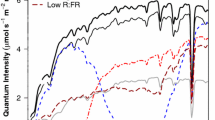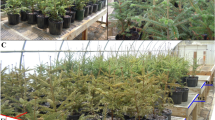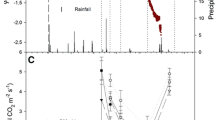Abstract
Few pine species develop a seedling grass stage; this growth phase, characterized by strong, carrot-like taproots and a stem-less nature, poses unique challenges during nursery production. Fertilization levels beyond optimum could result in excessive diameter growth that reduces seedling quality as measured by the root bound index (RBI). We grew longleaf pine (Pinus palustris), a grass stage species, in containers of four different volumes (60–336 ml) either coated with copper oxychloride or left untreated and fertilized at low, medium, or high levels of nitrogen (N). In general, N concentration of tissues rose as N rate increased, with larger changes in concentration occurring between low and medium levels than between medium and high levels. N rate influenced root tissue N concentration less than it did stems and needles. Subtle needle color differences caused by N rate were significant, suggesting its potential utility during nursery production. As expected, seedlings grew larger as container volume increased and as N rate increased. Copper treatment, which we posited could influence the RBI, tended to increase root-collar diameter and tap root biomass and decrease total root volume. Chlorophyll abundance was affected more by N rate than by container volume or copper treatment, but photosynthesis was affected more by copper treatment than N rate or container size. Although RBI was 25 % greater for seedlings grown in small containers with high N rates than those grown in large containers with low N rates, RBI ranged only from 11 to 15 %, well below the critical 27 % threshold.


Similar content being viewed by others
References
[ASTM] American Society for Testing and Materials (1989) Standard test method for specifying color by the Munsell system. American Society for Testing and Materials. Annual book of ASTM standards D 1535-89
Aldrete A, Mexal JG, Phillips R, Vallotton AD (2002) Copper coated polybags improve seedling morphology for two nursery-grown Mexican pine species. For Ecol Manag 163:197–204
Aphalo P, Rikala R (2003) Field performance of silver-birch planting-stock grown at different spacing in containers of different volume. New For 25:93–108
Balisky AC, Salonius P, Walli C, Brinkman D (1995) Seedling roots and the forest floor: misplaced and neglected aspects of British Columbia’s reforestation effort? For Chron 71:59–65
Barnett JP (1984) Top pruning and needle clipping of container-grown southern pine seedlings. In: Lantz C (ed) Proceedings of the southern nursery conference. USDA Forest Service, Southern Region, State & Private Forestry, pp 39–45
Barnett JP (1989) Shading reduces growth of longleaf and loblolly pine seedlings in containers. Tree Plant Notes 40(1):23–26
Barnett JP (1999) Longleaf pine ecosystem restoration. J Sustain For 9:89–96
Barnett JP (2002) Longleaf pine: why plant it? Why use containers? In: Barnett JP, Dumroese RK, Moorhead DJ (eds) Proceedings of workshops on growing longleaf pine in containers—1999 and 2001. USDA Forest Service, Southern Research Station, Gen Tech Rep SRS-56, pp 5–7
Barnett JP, McGilvray JM (2002) Copper-treated containers influence root development of longleaf pine seedlings. In: Barnett JP, Dumroese RK, Moorhead DJ (eds) Proceedings of workshops on growing longleaf pine in containers—1999 and 2001. USDA Forest Service, Southern Research Station, Gen Tech Rep SRS-56, pp 24–26
Barnett JP, Hainds MJ, Hernandez GA (2002) Interim guidelines for growing longleaf seedlings in containers. In: Barnett JP, Dumroese RK, Moorhead DJ (eds) Proceedings of workshops on growing longleaf pine in containers—1999 and 2001. USDA Forest Service, Southern Research Station, Gen Tech Rep SRS-56, pp 27–29
Brissette JC, Elliott M, Barnett JP (1990) Producing container longleaf pine seedlings. In: Farrar RM Jr (ed) Proceedings of the symposium on the management of longleaf pine. USDA Forest Service, Southern Forest Experiment Station, Gen Tech Rep SO-75, pp 52–70
Brissette JC, Barnett JP, Landis TD (1991) Container seedlings. In: Duryea ML, Dougherty PM (eds) Forest regeneration manual. Springer, Dordrecht, pp 117–141
Burdett AN (1978) Control of root morphogenesis for improved mechanical stability in container-grown lodgepole pine. Can J For Res 8:483–486
Burdett AN (1979) A nondestructive method for measuring the volume of intact plant parts. Can J For Res 9:120–122
Burdett AN, Martin PAF (1982) Chemical root pruning of coniferous seedlings. HortScience 16:622–624
Burdett AN, Coates H, Eremko R, Martin PAF (1986) Toppling in British Columbia’s lodgepole pine plantations: significance, cause and prevention. For Chron 62:433–439
Davis AS, Ross-Davis AL, Dumroese RK (2011) Nursery culture impacts cold hardiness in longleaf pine (Pinus palustris) seedlings. Restor Ecol 19:717–719
Dong H, Burdett AN (1986) Chemical root pruning of Chinese pine seedlings raised in cupric sulfide impregnated paper containers. New For 1:67–73
Dumroese RK (2002) An outside perspective on growing longleaf pine—thoughts from a nursery manager in the Pacific Northwest. In: Barnett JP, Dumroese RK, Moorhead DJ (eds) Proceedings of workshops on growing longleaf pine in containers—1999 and 2001. USDA Forest Service, Gen Tech Rep SRS-56, pp 35–42
Dumroese RK, Wenny DL (1997) An assessment of ponderosa pine seedlings grown in copper-coated polybags. Tree Plant Notes 48(3):60–64
Dumroese RK, James RL, Wenny DL (2002) Hot water and copper coatings in reused containers decrease inoculum of Fusarium and Cylindrocarpon and increase Douglas fir seedling growth. HortScience 37:943–947
Dumroese RK, Parkhurst J, Barnett JP (2005) Controlled release fertilizer improves quality of container longleaf pine seedlings. In: Dumroese RK, Riley LE, Landis TD (tech coords) National proceedings, forest and conservation nursery associations—2004. USDA Forest Service, Proceedings RMRS-P-35, pp 3–8
Dumroese RK, Barnett JP, Jackson DP, Hainds MJ (2009) 2008 Interim guidelines for growing longleaf pine seedlings in container nurseries. In: Riley LE, Dumroese RK (tech coords) National proceedings, forest and conservation nursery associations—2008. USDA Forest Service, Proceedings RMRS-P-58, pp 101–107
Dunn GM, Huth JR, Lewty MJ (1997) Coating nursery containers with copper carbonate improves root morphology of five native Australian tree species used in agroforestry systems. Agrofor Syst 37:143–155
Fiedler HJ, Nebe F, Hoffman W (1973) Forstliche Pflanzenernährung und Düngung. G Fisher, Stuttgart
Grossnickle SC (2000) Ecophysiology of northern spruce species: the performance of planted seedlings. NRC Research Press, Ottawa 409
Hainds MJ (2002a) Marketing and seedling distribution of longleaf pine seedlings. In: Barnett JP, Dumroese RK, Moorhead DJ (eds) Proceedings of workshops on growing longleaf pine in containers—1999 and 2001. USDA Forest Service, Gen Tech Rep SRS-56, p 58
Hainds MJ (2002b) Longleaf seedling trends. In: Barnett JP, Dumroese RK, Moorhead DJ (eds) Proceedings of workshops on growing longleaf pine in containers—1999 and 2001. USDA Forest Service, Gen Tech Rep SRS-56, pp 3–4
Hainds MJ (2004) Establishing longleaf pine seedlings on agricultural fields and pastures. In: Connor KF (ed) Proceedings of the 12th biennial southern silvicultural research conference. USDA Forest Service, Gen Tech Rep SRS-71, pp 309–313
Haywood JD, Sung SS, Sword Sayer MA (2012) Copper root pruning and container cavity size influence longleaf pine growth through five growing season. South J Appl For 36:146–151
Heiskanen J (2005) Foliar colour as an indicator of foliar chlorophyll and nitrogen concentration and growth in Norway spruce seedlings. Scand J For Res 20:329–336
Jackson DP, Dumroese RK, Barnett JP (2012) Nursery response of container Pinus palustris seedlings to nitrogen supply and subsequent effects on outplanting performance. For Ecol Manag 265:1–12
Johnson JD (1984) A rapid technique for estimating total surface of pine needles. For Sci 30:913–921
Jose S, Jokela EJ, Miller DL (eds) (2006) The longleaf pine ecosystem-ecology, silviculture, and restoration. Springer, New York, p 438
Keeley JE (2012) Ecology and evolution of pine life histories. Ann For Sci 69:445–453
Kush JS, Meldahl RS, McMahon CK, Boyer WD (2004) Longleaf pine: a sustainable approach for increasing terrestrial carbon in the southern United States. Environ Manag 33(Suppl 1):S139–S147
Lambert DH, Weidensaul TC (1982) Copper requirements of container-grown conifer seedlings. Can J For Res 12:848–852
Landis TD (1985) Mineral nutrition as an index of seedling quality. In: Duryea ML (ed) Proceedings: evaluating seedling quality: principles, procedures, and predictive abilities of major tests. Oregon State Univ, Forest Research Lab, Corvallis, pp 29–48
Landis TD (1989) Mineral nutrients and fertilization. In: Landis TD, Tinus RW, McDonald SE, Barnett JP (eds) Seedling nutrition and irrigation. The container tree nursery manual, vol 4. USDA Forest Service, Ag Handbook 674, Washington, pp 1–67
Landis TD (2012) Managing surplus or holdover nursery stock. USDA Forest Service. For Nurs Notes 30(1):10–12
Landis TD, Dumroese RK (2006) Applying the target plant concept to nursery stock quality. In: MacLennan L, Fennessy J (eds) Plant quality: a key to success in forest establishment. Proceedings of the National Council for Forest Research and Development (COFORD) conference, Dublin, Ireland, pp 1–10
Landis TD, van Steenis E (2000) Micronutrients: copper. Tree Plant Notes 49(3):44–48
Landis TD, Tinus RW, McDonald SE, Barnett JP (1989) Seedling nutrition and irrigation. The container tree nursery manual, vol 4. USDA Forest Service, Ag Handbook 674, Washington
Landis TD, Tinus RW, McDonald SE, Barnett JP (1990) Containers and growing media. The container tree nursery manual, vol 2. USDA Forest Service, Ag Handbook 674, Washington
Landis TD, Steinfeld DE, Dumroese RK (2010) Native plant containers for restoration projects. Nativ Plants J 11:341–348
Linder S (1980) Chlorophyll as an indicator of nitrogen status of seedlings. N Z J For Sci 10:166–175
Moran R, Porath D (1980) Chlorophyll determination in intact tissues using N, N’-dimethylformamide. Plant Physiol 65:478–479
Oliet JA, Artero F, Cuadros S, Puértolas J, Luna L, Grau JM (2012) Deep planting with shelters improves performance of different stocktype sizes under arid Mediterranean conditions. New For 43:925–939
Outcalt KW (2000) The longleaf pine ecosystem of the South. Nativ Plants J 1:42–44, 47–53
Pinto JR, Dumroese RK, Davis AS, Landis TD (2011a) Conducting seedling stocktype trials: a new approach to an old question. J For 109:293–299
Pinto JR, Marshall JD, Dumroese RK, Davis AS, Cobos DR (2011b) Establishment and growth of container seedlings for reforestation: a function of stocktype and edaphic conditions. For Ecol Manag 261:1879–1884
Pinto JR, Marshall JD, Dumroese RK, Davis AS, Cobos DR (2012) Photosynthetic response, carbon isotopic composition, survival, and growth of three stocktypes under water stress enhanced by vegetative competition. Can J For Res 42:333–344
Porra RJ, Thompson WA, Kriedemann PE (1989) Determination of accurate extinction coefficients and simultaneous equations for assaying chlorophylls a and b extracted with four different solvents: verification of the concentration of chlorophyll standards by atomic absorption spectroscopy. Biochim Biophys Acta 975:384–394
Ritchie GA, Landis TD, Dumroese RK, Haase DL (2010) Assessing plant quality. In: Landis TD, Dumroese RK, Haase DL (eds) Seedling processing, storage, and outplanting. The container tree nursery manual, vol 7. USDA Forest Service, Ag Handbook 674, Washington, pp 17–81
Ruehle JL (1985) The effect of cupric carbonate on root morphology of containerized mycorrhizal seedlings. Can J For Res 15:586–592
Salifu KF, Jacobs DF (2006) Characterizing fertility targets and multi-element interactions in nursery culture of Quercus rubra seedlings. Ann For Sci 63:231–237
Salonius P, Hallett R, Beaton K, French C (2002) Extended nursery rearing compromises field performance of container-reared conifer seedlings. Canadian Forest Service, Atlantic Forestry Centre, Info Rep M-X-214E, p 21
Saul GH (1968) Copper safely controls roots of tubed seedlings. Tree Plant Notes 19(1):7–9
Sims JL, Patrick WH Jr (1977) The distribution of micronutrient cations in soil under conditions of varying redox potential and pH. Soil Sci Soc Am J 42:258–262
South DB, Mitchell RG (2006) A root-bound index for evaluating planting stock quality of container-grown pines. S Afr For J 207:47–54
South DB, Shelton J, Enebak SA (2001) Geotropic lateral roots of container-grown longleaf pine seedlings. Nativ Plants J 2:126–130
South DB, Carey WA, Johnson DA (2004) Copper deficiency in pine plantations in the Georgia coastal plain. Proceedings of the 12th biennial southern silvicultural research conference. USDA Forest Service, Gen Tech Rep SRS-71, pp 387–390
South DB, Harris SW, Barnett JP, Hainds MJ, Gjerstad DH (2005) Effect of container type and seedling size on survival and early height growth of Pinus palustris seedlings in Alabama, U.S.A. For Ecol Manag 204:385–398
Struve DK (1993) Effect of copper-treated containers on transplant survival and regrowth of four tree species. J Environ Hortic 11:196–199
Sung S-JS, Haywood JD, Sword-Sayer MA, Connor KF, Scott AD (2010) Effects of container cavity size and copper coating on field performance of container-grown longleaf pine seedlings. In: Stanturf JA (ed) Proceedings of the 14th biennial southern silvicultural research conference. USDA Forest Service, Gen Tech Rep SRS-GTR-121, pp 241–245
Svenson SE, Davies FT Jr (1992) Comparison of methods for estimating surface area of water-stressed and fully hydrated pine needle segments for gas exchange analysis. Tree Physiol 10:417–421
Sword Sayer MA, Brissette JC, Barnett JP (2005) Root growth and hydraulic conductivity of southern pine seedlings in response to soil temperature and water availability after planting. New For 30:253–272
Sword Sayer MA, Haywood JD, Sung S-JS (2009) Cavity size and copper root pruning affect production and establishment of container-grown longleaf pine seedlings. For Sci 55:377–389
Sword Sayer MA, Sung S-JS, Haywood JD (2011) Longleaf pine root system development and seedling quality in response to copper root pruning and cavity size. South J Appl For 35:5–11
van den Driessche R (1989) Nutrient deficiency symptoms in container-grown Douglas-fir and white spruce seedlings. Forestry Canada and British Columbia Ministry of Forests. Forest Resource Development Agreement (FRDA) Rep 100. p 29
van den Driessche R (1991) Mineral nutrition of conifer seedlings. CRC Press, Boca Raton
van Steenis E (1994) Growing in copper treated containers requires greater awareness. British Columbia Ministry of Forests. Seed Seedl Ext Top 7(2):4–5
Vogel JG, Jokela EJ (2011) Micronutrient limitations in two managed southern pine stands planted on Florida spodosols. Soil Sci Soc Am J 75:1117–1124
Wenny DL, Woollen RL (1989) Chemical root pruning improves the root system morphology of containerized seedlings. West J Appl For 4:15–17
Acknowledgments
This project was supported by the USDA Forest Service Southern Research Station, Rocky Mountain Research Station, and the National Center for Reforestation, Nurseries, and Genetic Resources. We thank B Bird (statistician, Rocky Mountain Research Station) and JP Barnett (emeritus scientist, Southern Research Station) for their contributions, as well as the associate editor and anonymous reviewers for their insightful comments.
Author information
Authors and Affiliations
Corresponding author
Rights and permissions
About this article
Cite this article
Dumroese, R.K., Sung, SJ.S., Pinto, J.R. et al. Morphology, gas exchange, and chlorophyll content of longleaf pine seedlings in response to rooting volume, copper root pruning, and nitrogen supply in a container nursery. New Forests 44, 881–897 (2013). https://doi.org/10.1007/s11056-013-9377-5
Received:
Accepted:
Published:
Issue Date:
DOI: https://doi.org/10.1007/s11056-013-9377-5




